Wisteria (wisteria) - for a luxurious garden decoration
Amazing plant, wisteria, recognized as one of the most impressive in the world. This gorgeous liana wraps its velvet paws full of delicate fragrant inflorescences around gazebos, arches, houses and any other vertical supports available to it. Wisteria wisteria is considered the most exotic and most unusual loach of the legume family. Rich clusters of flowers hang vertically from the supports, giving the impression of a picturesque fairy tale.
Every florist dreams of having an exotic beauty on his site, and landscape designers more and more often resort to its use when landscaping vertical planes. A short body of knowledge about this amazing loach will help you make your choice, learn the basic rules of growing and care. Tips from experienced florists will tell you how you can beat the beauty of a plant on your site.
Content
- Description of wisteria wisteria
- Growing conditions for wisteria
- Reproduction methods
- Correct care
- Top dressing and shelter for the winter
- Application in landscape design
Description of wisteria wisteria
Wisteria belongs to the legume family. It is a climbing plant reaching 20 meters in length, depending on the species and place of growth. The greenery consists of feathery leaves, bright green in color. Flowers are collected in clusters from 10 to 70 cm long. The color of the inflorescences varies from white to rich purple hues, sometimes you can find dark red flowers.
Wisteria vines twine around the supports strictly clockwise.
As the plant grows, it suppresses neighboring crops, this must be taken into account when choosing a place for planting. Wisteria prefers sunny areas with fertile soil. When planning to grow this noble plant, one should take into account its toxicity. Groundwater should not touch powerful root system loach. Wisteria grows wild in the northeastern parts of America, China, Japan and Korea.
The most luxurious and abundant bloom in the bosom of nature can be observed in California. In the Sierra Madre site, wisteria has covered an acre of land. The impressive jungle is an impenetrable carpet covered with flowers. According to some estimates, the weight of this carpet reaches 250 tons. Wisteria vines are very heavy and require strong supports, otherwise they can break an unreliable structure. The plant is grown to decorate vertical structures such as arches, gazebos, house walls, fences and trellises. Depending on the object, the support, the type of plant is chosen.
Growing conditions for wisteria
Growing tips:
- By and large, wisteria can grow both on fertile soils and on poor ones. But if the florist wants to achieve abundant flowering and the density of foliage, it is better to grow it in fertile soil.
- The main condition for the successful growth and development of vines is good sunlight. The plant should be in the sun for at least six hours a day.
- Another essential attribute for growing wisteria is a reliable support. For such a serious loach, supports are built with a base of concrete-cement screed.The best option would be a metal structure, it will not bend under the weight of vines and will not fall under the influence of strong winds.
- If you plan to shade the house with wisteria, pay attention to the roof. It must be strong, otherwise the vines will make their way under it and destroy the structure. The support should be made in such a way that the inflorescences hang vertically and not get lost in the greenery. In this case, lush and elegant clusters will delight the eye.
- During the growth period, it is necessary to monitor the soil moisture. Wisteria loves moisture, but not excessive moisture. Therefore, in constantly damp areas, before planting a vine, the soil must be drained.
It is very important to create conditions close to natural conditions for the vines. Try to choose an area where the root of the plant would be in the shade, and the vine itself is in the sun. In the wild, this is how it grows, stretches like a lotus from the darkness to the sun.
Otherwise, wisteria is quite unpretentious and grows on its own if there is access to the sun during the day, and the soil is moderately moist.
Reproduction methods
Wisteria wisteria reproduces with the help seed or cuttings... Since the plant belongs to the legume family, it is propagated like the most common peas. As the vines grow, pods with fruits appear on it - seeds. Beans begin to be planted at home in early winter. For this you need to prepare the ground. Take 4 parts of leafy soil, one part of turf and one part of sand.
Drainage from expanded clay or broken brick is laid in a pot for planting, prepared soil is poured onto it.
Water the soil a little and plant the beans. Cover the flowerpot with foil and put it in a dark place. After about a month, the seeds will sprout. As soon as this happens, immediately expose the container to the light. A plant that has reached the size of a small bush is planted in a greenhouse in spring. When you see that the root system has grown stronger and the bush has begun to grow, transplant it to the planned permanent place.
Propagation by cuttings:
- In the store you can buy ready-made and germinated cuttings of vines. Better to purchase one-year-old or two-year-old plants. They will take root better.
- Landing produced in the spring in a permanent place prepared for the vine.
- The soil needs to be fed mineral fertilizers.
- When planting, the cutting is cut and shaped. Many growers advise making an incision approximately in the middle of the cutting, then deepening it in the soil along this cut.
- After some time, the plant will give lateral layers.
- In August, the vine transplanted to a permanent place.
Whether the stalk is planted in one way or another, as practice shows, it will still begin to grow and weave.
Correct care
Taking care of wisteria is not that difficult. If all planting conditions are met and a good area with constant solar lighting is chosen, all that is required from the grower is timely pruning... It plays an important role in the cultivation of wisteria. The formation of a vine requires a constant garter of new shoots. Cropping comes down to the following:
- When planted in the first year of life, the main stem is trimmed to whichever bud is the strongest. Lateral shoots are cut off. As it grows, the main stem is tied vertically, and the side ones diagonally.
- In the second year of the plant's life, the main stem is trimmed again according to the same principle as when planting. The shoots running horizontally are shortened.
- In the third year of the liana's life, in addition to the main stem, new leading vines grow. They are also trimmed and fixed to the support vertically. Lateral shoots are shortened and fastened diagonally. Small shoots at the base are removed. It is necessary to constantly monitor the garter, it should not overtighten the vines and damage them.
- In all subsequent years of the plant's life pruning and the garter is in the third year of growth.
These simple rules of care will help the grower to form a luxurious, blooming liana.However, you should be patient, the peak of flowering and growth of wisteria falls on the third or fourth year of life. It grows rather slowly. Pruning and garter will speed up growth, but not that much.
Top dressing and shelter for the winter
In the spring and during disembarkation, the wisteria should be fed with complex mineral fertilizerscontaining phosphate-potassium compounds. Be careful when applying nitrogen preparations to the soil.
With an excess of them, wisteria will not bloom, and the greens will become faded, colorless. In the fall, the vines are lowered and covered in several layers with non-woven material. Many cover the plant with a film and roofing material.
Despite the frost resistance, the liana must be covered, and quite tightly.
These simple care rules will help the grower grow properly. wisteria... After a couple of years, she will begin to delight with her exotic flowering and beauty.
Application in landscape design
In landscape design, they often resort to wisteria. She is the most beautiful and impressive vine in the world:
- Designers use it for hanging gardens, gazebos and alleys. For example, many experienced florists build a row arches made of metal along the length of the track. Over time, as the vines grow, the arches become covered with dense greenery, and the bunch of flowers hang from the "roofs" of the arches. The impression of a road to paradise is created. A delicate fruity aroma makes you return to the liana again and again.
- Very often, they resort to wisteria if they want to cover the walls of the house with greenery and luxury of flowers. To do this, trellises are attached to the walls and a vine is directed along them.
- Designers very often resort to the technique of creating vertical structures covered with wisteria. For example, gazebos, entwined with greenery with cascading clusters of delicate purple flowers. For this, gratings are constructed around the perimeter and on top of metal or other durable material. In a year or two, it will be covered with jungle from wisteria, and bunches of flowers will harmoniously and densely hang from the roof and on the sides - an incomparable sight. A table, rocking chairs or other pieces of garden furniture are installed inside.
- With the help of vines, you can hide nondescript stone fences, they will turn into the most picturesque hedge in the area. Design solutions will decorate and ennoble the site, and the beauty of wisteria will become the highlight of your garden.
It is not difficult to grow a plant, you just need to correctly choose a place for it and build a reliable support. Following the rules for leaving and planting, the florist will be able to count on abundant bloom after a couple of years of growth. Wisteria will become your favorite and most unusual plant in the garden. Good luck in growing the unearthly beauty of the loach!
More information can be found in the video.



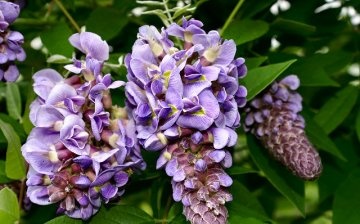
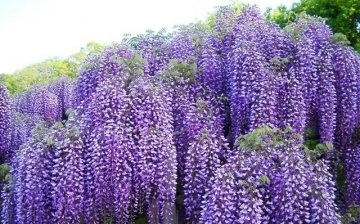


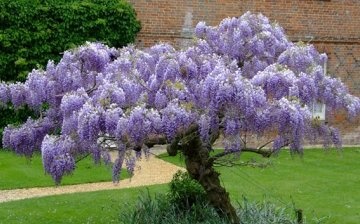
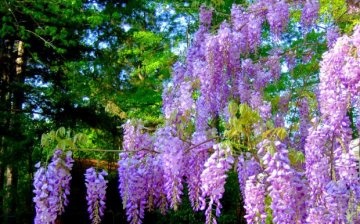








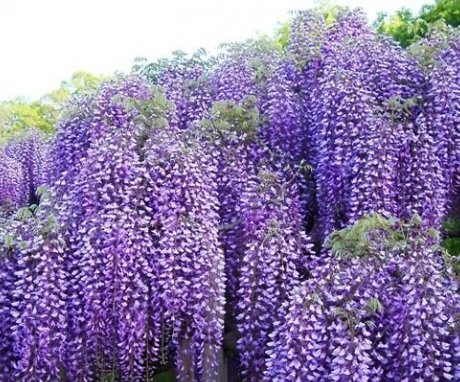
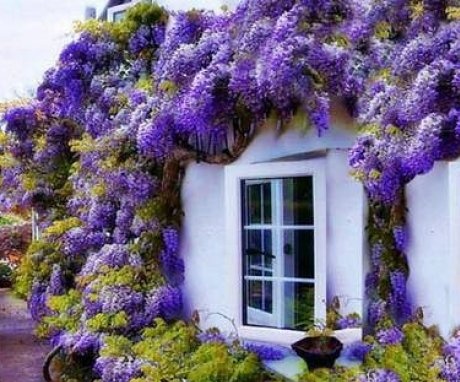
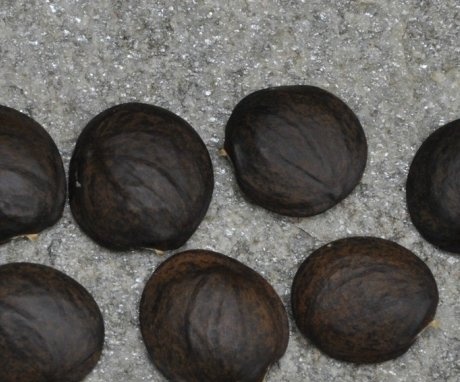
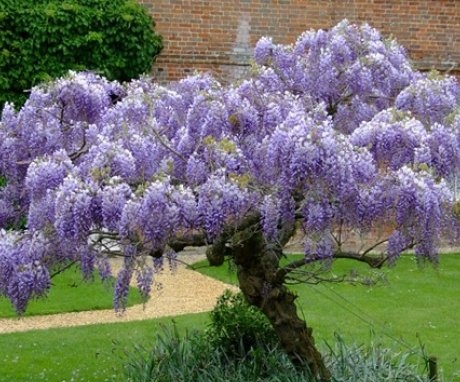
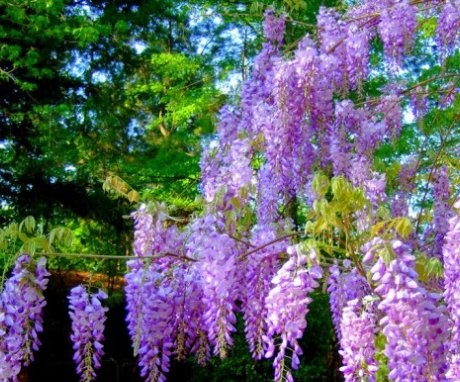
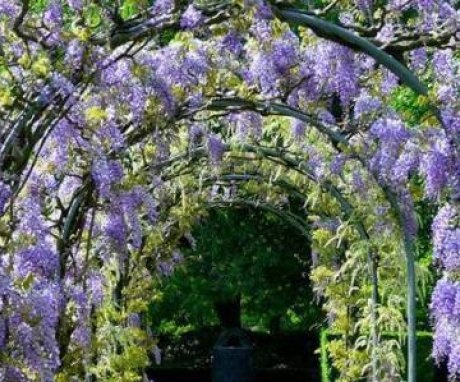
No matter how much I plant Wisteria, it does not take root with me. Share tips on how anyone managed to plant this beautiful plant. For some reason, it dries up, although I water it moderately, I make sure that the soil is always moist.
The flowering of this plant is very much like a lilac, but at the same time it winds in itself, you can use it to make beautiful arches. I also planted a plant once, but for some reason it did not take root.